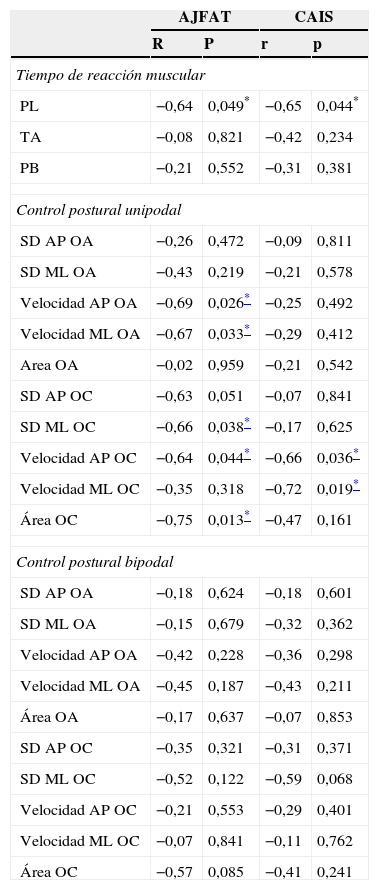Determinar la correlación entre evaluaciones del control postural y neuromuscular con cuestionarios de percepción subjetiva en deportistas con inestabilidad funcional de tobillo.
Material y métodoEstudio descriptivo con un diseño correlacional. Participaron 10 deportistas de género masculino. El control postural fue medido a partir del desplazamiento del centro de presión (COP) en direcciones medio-lateral (ML) y antero-posterior (AP), obteniendo las siguientes variables: área, variabilidad ML, variabilidad AP, velocidad ML y velocidad AP. Se evaluó en bipodal y unipodal con ojos abiertos (OA) y ojos cerrados (OC). El tiempo de reacción de los músculos peroneus longus (PL), peroneus brevis (PB) y tibialis anterior (TA) se registró durante una prueba de inversión repentina de tobillo. Se aplicaron 2 cuestionarios de percepción funcional de tobillos: AJFAT y CAIS. El análisis estadístico que se realizó fue la prueba de Pearson, con un nivel de significación de 0,05.
ResultadosExiste correlación negativa moderada del músculo PL con el cuestionario AJFAT (r=–0,64; p=0,049) y también con el cuestionario CAIS (r=–0,65; p=0,044). Se observan correlaciones negativas fuertes existentes entre el cuestionario AJFAT y área del COP en OC y unipodal (r=–0,75; p=0,013), y entre el cuestionario CAIS y velocidad ML del COP en OC y unipodal (r=–072; p=0,019).
ConclusionesEl uso de los cuestionarios aplicados en este estudio podrían ser útiles para evaluar las limitaciones funcionales de los sujetos que presenten inestabilidad funcional de tobillo, favoreciendo el abordaje fisioterapéutico de estos pacientes.
To determine the correlation between postural and neuromuscular control assessments and questionnaires of subjective perception in athletes with functional ankle instability.
Material and methodsA descriptive study with a correlational design was performed. Ten male athletes participated. Postural control was measured from the displacement of the center of pressure (COP) in the medio-lateral (ML) and anteroposterior (AP) directions. The following variables were obtained: area, ML variability, AP variability, ML velocity and AP velocity. Bipodal and unipodal measurements with opened eyes (OE) and closed eyes (CE) were made. Muscle reaction time of peroneus longus (PL), peroneus brevis (PB) and tibialis anterior (TA) was recorded with surface electromyography in sudden ankle inversion test. Functional ankle perception questionnaires were administered: AJFAT and CAIS. The statistical analysis was performed with the Pearson Test. Significance level was established a priori at P<0.05.
ResultsThere was a moderate negative correlation between AJFAT with PL muscle (r=-0.64, P=0.049) and with the CAIS and PL muscle (r=-0.65, P=0.044). Strong negative correlations were observed between the AJFAT questionnaire and COP area in unipodal EC (r=-0.75, P=0.013) and between the CAIS questionnaire and COP velocity ML in and unipodal EC (r=-072, P=0.019).
ConclusionsThe use of questionnaires applied in this study could be useful in assessing the functional limitations of patients with functional ankle instability, favoring the physiotherapy approach to these patients.
Artículo
Si ya tiene sus datos de acceso, clique aquí.
Si olvidó su clave de acceso puede recuperarla clicando aquí y seleccionando la opción "He olvidado mi contraseña".Comprando el artículo el PDF del mismo podrá ser descargado
Precio 19,34 €
Comprar ahora










